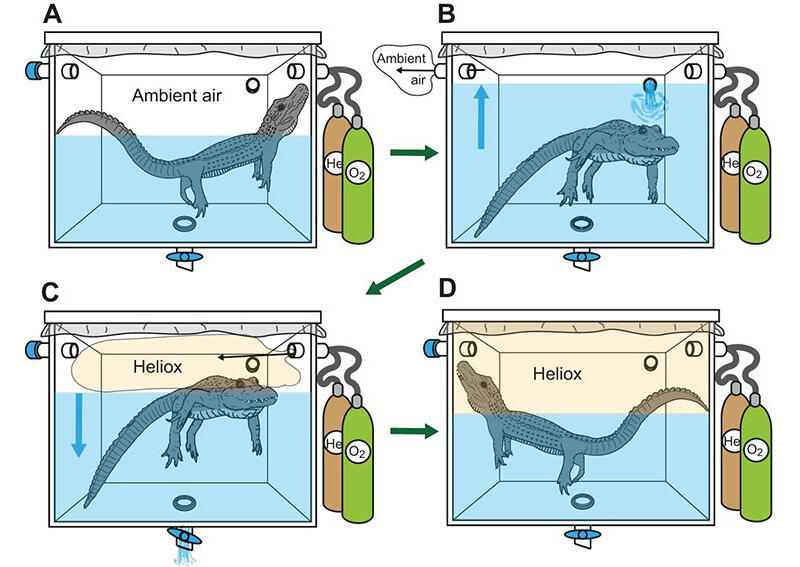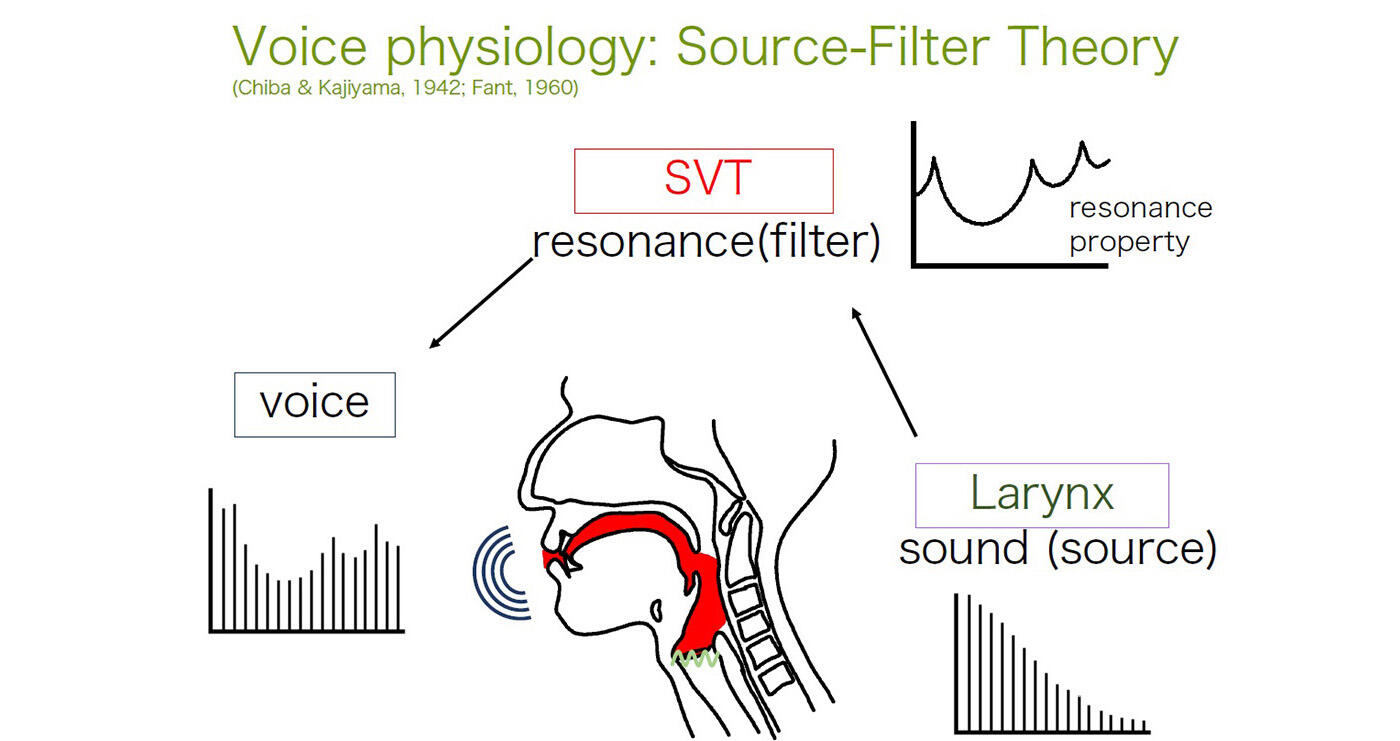
(Photo provided by: Takeshi Nishimura and Jim Darlington)
The Ig Nobel Prize is the award presented to research that makes people laugh and then think. The 2020 Ig Nobel Acoustics Prize was won by Takeshi Nishimura, Associate Professor at Kyoto University's Primate Research Institute, for his research that revealed the principle that alligators, like humans, change their voices when they inhale helium gas. He received this award jointly with a member of his research group at the University of Vienna. Dr. Nishimura says that his study, which had started with a sense of fun, evolved through human connections and led to discovering new truths. What is the nature of the research that won the Ig Nobel Prize?
The Ig Nobel Prize Makes People Laugh and Think
The Ig Nobel Prize focuses on "pure curiosity" and conveys it to the world with laughter and satire. The prize was established in 1991 by the editor-in-chief of a foreign humorous science magazine as a literal parody of the Nobel Prize. Although it is a parody, there are have been cases like the Dutch physicist Dr. Andre Geim. He won the Ig Nobel Prize for his "magnetic levitation of frogs" and the Nobel Prize for his "innovative experiments on graphene, a new carbon material, respectively.
Japanese have won the prize for 14 consecutive years. To name a familiar one, Japan-born Karaoke won the 2004 Peace Prize for "providing a new way for people to tolerant each other. As for research achievements, a Japanese won the Physics Prize in 2014 for "measuring the frictional force when a person steps on a banana peel on the floor. Although the range of the award-winning themes is extensive, the underlying principle of "make people laugh, and then think" remains unchanged. And in 2020, Dr. Nishimura and his co-researchers were awarded the Acoustics Prize.
It is essential in research to "joke around seriously" with a sense of fun to reveal the academic principles behind things that people take for granted. This research was no different. The research group at the University of Vienna, led by Stephan Reber, studying birds, looked at the entire reptilian family, of which birds are a part. He thought, "Alligators, like chickens, also make noises, so we can learn something by making them inhale helium gas. By analyzing the alligator calls made when it inhaled helium gas, he found that alligators, like birds and mammals, use the principle of air resonance in the vocal tract to make their calls.

(Photo provided by: Seth Burdick)
How to get an alligator to inhale helium gas?
The mechanism by which living organisms produce their voices is complicated to clarify. It requires complex dissection and sensing techniques if you want to examine the movement of the vocal organs. However, if the goal is to find out the principle of voice production, you can clarify many things simply by having them inhale helium gas and analyzing the changes in their voices.
So, how can we get an alligator to inhale helium gas when it cannot communicate with us? Just spraying over as we do to a human would not be enough to fill the alligator's vocal tract and lungs with helium gas, making the experiment impossible. The research group then took note of the characteristic of alligators that when they run out of oxygen in the water, they peek out of the water and take a deep breath. And they solved the problem by making their alligator inhale helium gas at that time.

(Photos provided by: Judith Janisch and Stephan Reber).

(Photos provided by: Judith Janisch and Stefan Reber)
Fill the sealed tank with water and remove the ambient air. Instead of air, fill the top of the tank with heliox gas (a mixture of helium and oxygen to achieve air oxygen concentration). When the alligator peeks out of the water surface and takes a deep breath, it will inhale plenty of helium gas along with oxygen into its lungs.

The voices of the alligator recorded in this way were hoarse, like burping, and could not be analyzed by the usual methods using software, unlike the voice of birds, which has a beautiful voice. Once again, the research group members faced the complex problem of "how to analyze the voice of an alligator." In this situation, Mr. Nishimura, a visiting researcher at the University of Vienna for a year term, was asked to participate in this research because of his experience in speech analysis on monkeys with helium gas. And they overcame this challenge by adding manual analysis instead of just relying on the semi-automated analysis software. After such repeated difficulties, it became clear from the change in voice when the alligator inhaled helium gas that the alligator uses resonance to vocalize, just like humans.
Distinguish between sounds and voices using helium
Why does inhaling helium gas change your voice in the first place?
Have you ever played the game that you change your voice by inhaling helium gas? All living things that vocalize, such as humans, change their voices when they inhale helium gas. However, frogs with a strong image of croaking do not sound different even when they inhale helium gas. That is because what they emit is not a voice but a sound.
There are two types of sounds produced by living things: sounds of objects and voices that use air resonance. Birds, who are said to be survivors of the dinosaurs, have the latter. However, birds are highly specialized in their vocal tracts and do not represent reptiles in general, including dinosaurs. It was unknown whether other reptiles produce their calls by rubbing or striking something or resonating air in their vocal tracts until this study.
Helium is very light compared to the molecules that make up the air. Sound is a vibration that travels through the air, so the lighter the air component is, the faster the speed of sound becomes. Even if the velocity of sound changes, the "mere" sound remains unchanged. Once sounds produced in vocal cords resonate in the vocal tract, only the sound of a specific frequency, appropriate to the speed of sound and the length of the vocal tract, is amplified and can be heard as a voice. Based on this principle, when the rate of sound changes in helium gas, the frequency of the sound in the voice changes, and the voice sounds different.
This research has revealed that "reptiles make sounds," so it is highly likely that dinosaurs also used their vast bodies to make their voices ring out.

I wish to get to the origin of human speech.
Mr. Nishimura, who is usually involved in research on primates, says jokingly, "Why not monkeys? Monkeys are more interesting than alligators."
When a researcher who is an expert in a particular field produces innovative research results, a cross-disciplinary coincidence sometimes plays a significant role. This award-winning research, which resulted from an encounter at the University of Vienna, where he stayed for a year, was indeed a product of "people meeting people.
Nishimura is currently working with a phonetics expert at the University of Music and Performing Arts Vienna, whom he met during his stay in Vienna, on clarifying how primates produce sounds. The research team focuses on the difference in voice production between "talking" and "singing" and hopes to get closer to the origin of human speech. It seems that "encounters between people" are further advancing the research.
Research is interesting because you reach an unexpected goal.
It's nice when things go as expected. But research is interesting because you reach an unexpected goal," says Nishimura. When you work on a research project that no one has seen before, such as this alligator voice project, you may encounter unexpected difficulties and breakthroughs achieved by overcoming them. He says he gets some enjoyment out of research, driven by pure curiosity and impulse.
The award ceremony usually takes place at Harvard University, but it did online for the first time this year. The Ig Nobel Prize winners receive a certificate, a trophy, a prize named after the prize contents, and 10 trillion Zimbabwe dollars * . But since the ceremony was online, they were all sent to the winners in email attachments, which they printed and assembled by themselves in time for the ceremony.
When I got the news from Stefan, I thought it was spam mail. I was surprised to receive the prize money, the trophy, all in PDF format," says Nishimura, smiling at the humor of the Ig Nobel Prize.

*The Zimbabwean dollar was once the legal tender issued in Zimbabwe, which hyperinflated and was eventually worth less than a yen to 10 trillion Zimbabwe dollars. Its use as a currency ceased in 2015. However, then governor of the Central Bank of Zimbabwe was awarded the 2009 Ig Nobel Mathematics Prize for "giving the public a way to train themselves to deal with huge numbers by issuing banknotes in denominations ranging from one cent to 100 trillion Zimbabwe dollars.
The Ig Nobel Prize may not have the same authority as the Nobel Prize. There seems to be a reason why it is still so popular among researchers and the general public. Most of the research results that have made significant contributions to humanity, for which Nobel Prizes are awarded, started from human curiosity and steady, tenacious research activities. Can't we say that the Ig Nobel Prize, which spotlights such research, also supports humanity?

Born in 1975. Ph.D. (Science). Associate Professor at Primate Research Institute, Kyoto University.
After completing his doctoral course at Kyoto University in 2003, he worked as a 21st Century COE researcher at the Primate Research Institute of the same university, followed by as a research fellow at the Japan Society for the Promotion of Science, and has been in his current position since 2007. He was a visiting researcher at the Department of Cognitive Biology, the University of Vienna, for one year starting in 2013.
Original article was provided by the Science Portal and has been translated by Science Japan.




